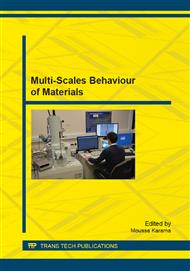p.1
p.12
p.27
p.39
p.51
p.64
p.74
p.83
Cellulose Whiskers Micro-Fibers Effect in the Mechanical Proprieties of PP and PLA Composites Fibers Obtained by Spinning Process
Abstract:
In this study, we present the manufacturing process of two new composites materials in the form of long fibers of polylactic-acid (PLA) or polypropylene (PP), reinforced by cellulose whiskers micro-fibers loads. In order to evaluate the mechanical properties of these advanced materials, a several uniaxial tensile tests were carried out. The PP and the PLA have initially been spinning without the addition of cellulose whiskers micro-fibers. In order to study the effects of cellulose whiskers micro-fibers reinforcements in the Mechanical behavior of the PLA and PP filaments, we determinate the proprieties of these advanced material from the tensile results. For the PP composite filaments material case, the whiskers reinforcement increases Young's modulus and failure resistance, but it reduces the limit strength failure. For the PLA composites the addition of 1% wt of cellulose whiskers from the total volume fraction of the material, increase the Young’s modulus more than 50% and a decrease of the failure resistance and the limit strength of composite. The obtained composites fibers are very rigid and brittle. What follows, that the addition of cellulose whiskers micro fibers in PP matrix, provides mechanical properties more convenient compared to the PLA matrix.
Info:
Periodical:
Pages:
12-26
Citation:
Online since:
December 2011
Authors:
Price:
Сopyright:
© 2012 Trans Tech Publications Ltd. All Rights Reserved
Share:
Citation:


